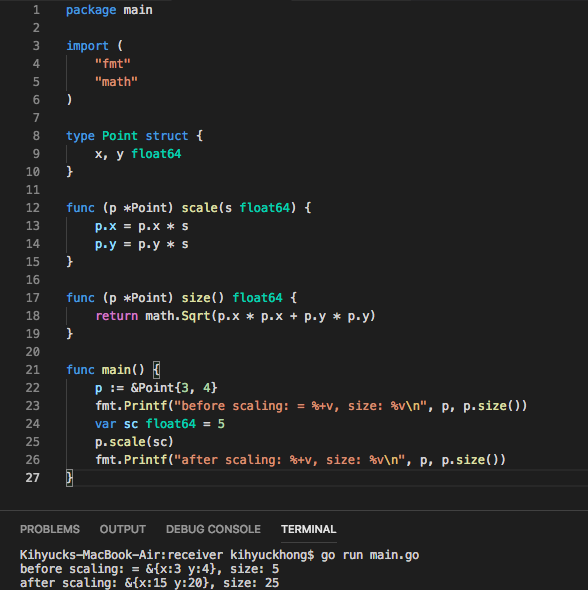GoLang Tutorial - Value or Pointer Receiver
There are two reasons to use a pointer receiver.
- The first is so that the method can modify the value that its receiver points to.
- The second is to avoid copying the value on each method call. This can be more efficient if the receiver is a large struct, for example.
In the following example, both scale and size are with receiver type *Point, even though the size method does not modify any elements of the Point struct receiver.

The code: pointer-receiver.go
Methods with pointer receivers can modify the value to which the receiver points (as scale does here). Since methods often need to modify their receiver, pointer receivers are more common than value receivers.
Try removing the * from the declaration of the scale function on line 12 and observe how the program's behavior changes:
// func (p *Point) scale(s float64) { ==>
func (p Point) scale(s float64) {
p.x = p.x * s
p.y = p.y * s
}
Output:
before scaling: = &{x:3 y:4}, size: 5
after scaling: &{x:3 y:4}, size: 5
With a value receiver, the scale method operates on a copy of the original Point value. (This is the same behavior as for any other function argument.) The scale method must have a pointer receiver to change the Point value declared in the main function.
Go Tutorial
- GoLang Tutorial - HelloWorld
- Calling code in an external package & go.mod / go.sum files
- Workspaces
- Workspaces II
- Visual Studio Code
- Data Types and Variables
- byte and rune
- Packages
- Functions
- Arrays and Slices
- A function taking and returning a slice
- Conditionals
- Loops
- Maps
- Range
- Pointers
- Closures and Anonymous Functions
- Structs and receiver methods
- Value or Pointer Receivers
- Interfaces
- Web Application Part 0 (Introduction)
- Web Application Part 1 (Basic)
- Web Application Part 2 (Using net/http)
- Web Application Part 3 (Adding "edit" capability)
- Web Application Part 4 (Handling non-existent pages and saving pages)
- Web Application Part 5 (Error handling and template caching)
- Web Application Part 6 (Validating the title with a regular expression)
- Web Application Part 7 (Function Literals and Closures)
- Building Docker image and deploying Go application to a Kubernetes cluster (minikube)
- Serverless Framework (Serverless Application Model-SAM)
- Serverless Web API with AWS Lambda
- Arrays vs Slices with an array left rotation sample
- Variadic Functions
- Goroutines
- Channels ("<-")
- Channels ("<-") with Select
- Channels ("<-") with worker pools
- Defer
- GoLang Panic and Recover
- String Formatting
- JSON
- SQLite
- Modules 0: Using External Go Modules from GitHub
- Modules 1 (Creating a new module)
- Modules 2 (Adding Dependencies)
- AWS SDK for Go (S3 listing)
- Linked List
- Binary Search Tree (BST) Part 1 (Tree/Node structs with insert and print functions)
- Go Application Authentication I (BasicAuth, Bearer-Token-Based Authentication)
- Go Application Authentication II (JWT Authentication)
Ph.D. / Golden Gate Ave, San Francisco / Seoul National Univ / Carnegie Mellon / UC Berkeley / DevOps / Deep Learning / Visualization